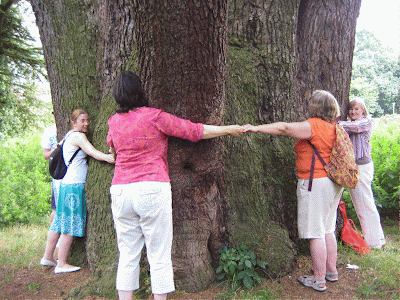So about our lovely cedar tree in St Stephen's field:
I have discovered that back in 1914 the then vicar wrote a letter to Kew Gardens giving the measurements of the famous cedar of Lebanon - then in what was the churchyard. It was pretty big at that time and that’s a century ago. From the reply it looked like they could not identify a larger specimen and so said that it was probably the largest of its kind in England – no mention of the other parts of the UK. It will be interesting to see how much it has grown in that time. We did measure the girth about 5 years ago when we did our tree hugging exercise and we estimated that it was about 9m – or seven adult hugs.
Back in 1914, the tree measured 26¼ft at 3ft from the ground (approx 8m) so it has grown about a metre in 100 years. We still have no accurate estimate of its age. Kew reckons that the previous oldest cedar tree cut down at Wilton House, measured 36ft at 5ft from the ground in 1874 and from its rings it was estimated that it dated from 1638. In order for our tree to fit the legend of King Henry canoodling with Anne Boleyn under it, it has got to be another hundred or so years older that the Wilton House one. Maybe we will never know until it dies and the rings can be counted - and we don’t want that to happen!
The almanac also gives details of what the original Vicarage and the garden looked like. The vicarage had twelve bedrooms/dressing rooms, several reception rooms, cellar and rooms for servants. Outside were small ‘home farm’ buildings viz: three brick cowsheds and pigsty; a cottage for the gardener/chauffeur of five rooms; stabling for 4 horses; two coach houses (or garages) large & small; four large coal and wood sheds ; and a dairy. It was demolished in the 1970s because it was vandalised by youths who took advantage of the generosity of the then incumbent, Rev Hart-Synnot. It must have been a wonderful house and garden in its day.
Here is a lovely description of the garden and grounds. “The Vicarage garden and grounds (of about 2¼ acres) are of great natural beauty. They include an orchard walled on two sides and adjoining the churchyard, a large lawn on the Eastside of the house and a small lawn on the West on Watling Street side, a large walled kitchen garden, a glade at the south side of the large lawn, two shrubberies with trees, a pleasant little wood with fine trees opening from the bottom of the large lawn. There is an ancient and picturesque well with the wheels and cogs of wood. It has not been used since the town water became available.” And there were tennis courts. What a lovely picture of what we have lost. At least the cedar is still standing!
--
Sandy Norman



No comments:
Post a Comment